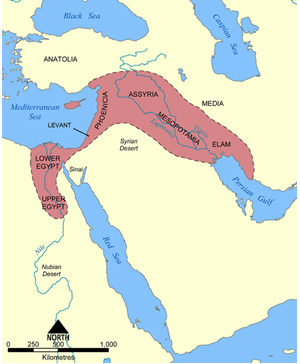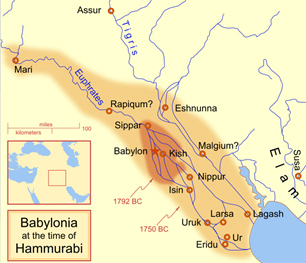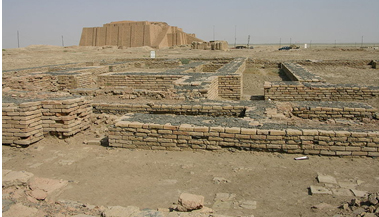
Source: Map of Eastern Mediterranean, Nile Delta, and Fertile Crescent, Resources for History Teachers

Source: Map of Eastern Mediterranean, Nile Delta, and Fertile Crescent, Resources for History Teachers
The river valley civilization of Mesopotamia occurred between the dates of 4000 B.C.-1760 B.C. Located in present-day Iraq, this civilization thrived in the area known as the Fertile Crescent.

Source: Map of Ancient Mesopotamia, Colt .55, Wikimedia
Located between the Tigris and Euphrates rivers, cities of Mesopotamia were populated along the rivers that would flow southward to the Persian Gulf.
The rivers would flood but the timing would be unpredictable. To ease the burden of flooding, the Mesopotamians built levees. If the land became too dry, then they would make holes in the levees. These channels eventually were enlarged to become canals and the water was used to water the crops.

Source: Hammurabi’s Babylonia 1, MapMaster, Wikimedia
Ur was one of the greatest cities in Mesopotamia. The citizens of Ur used mud from the river with crushed reeds to make bricks.
Notice the detail in the layers of stone in the building structure below.
In your notes, answer the following question. What do you think this building might have been used for?


Source: Ur-Nassiriyah, Wikimedia
A wall surrounded Ur. Even though Ur was surrounded by deserts and valleys, it was relatively easy for invaders to cross, that’s why the people of Ur built fortifications around their city. Winding streets led from the gates to the center of the city. The center of the city housed the upper class which was made up of merchants and priests.
In your notes, answer the following question. Why do you think the people saw merchants and priests as the upper class of society?

At the center of Ur was a ziggurat. A ziggurat was made up of a series of square levels.
![]() Click on the stairway in front of the ziggurat.
Click on the stairway in front of the ziggurat.
Source: Ziggurat of Ur 001, Tla2006, Wikimedia
In your notes, answer the following question. Why do you think this structure was the tallest building in the city?